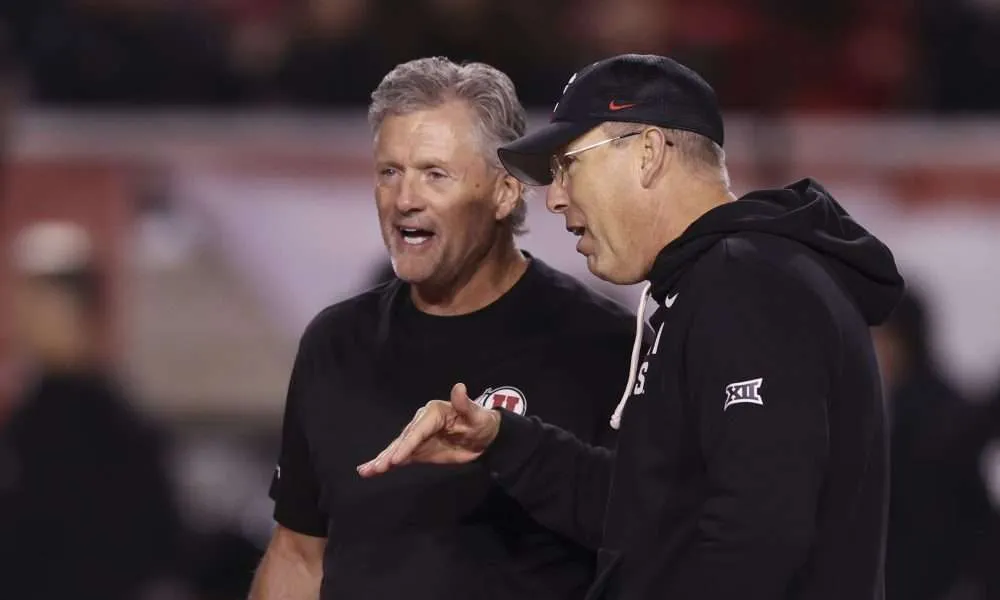NIL
Rossini aims for exponential growth in transitional year for college sports
May 2024 marked a brand new chapter in the history of Arizona State athletics, with the hiring of alumnus Graham Rossini as the university’s newest athletic director following the departure of Ray Anderson, who served in that capacity for roughly a decade.
Year one brought a whirlwind of unanticipated success for Sun Devil athletics as the school transitioned from its former home in the Pac-12 Conference to the Big 12 Conference in the vast majority of its sports. Despite this significant period of change, many Sun Devil programs saw significant success over the last nine months, winning four conference championships (football, volleyball, men’s, and women’s swimming).
On Thursday morning, Rossini held a press conference, which, among other topics, reviewed the first full sports year for ASU in their new conference.
“26 sports, 15 of them finished in the top 25,” Rossini noted in his opening remarks. “This last year, we had 10 combined first or second-place conference finishes, four Big 12 championships, which led the Big 12, and four Big 12 runners-up as well.
“I think the nation has started to really understand what we’re capable of accomplishing at Arizona State University. We want to win, we talk about Operation: Rings and Banners all the time, we want to compete at the highest level.”
Rossini credits a large portion of the success of the 2024–25 athletic year to the connectivity of the coaching staff across the department that has worked amongst themselves to foster growth at ASU. Rossini noted that the university coaching tree at ASU feels more intertwined now than it did back in May 2024.
“We no longer have these 26 sports that operate largely like independent contractors,” Rossini noted. “They’re connected, they’re collaborating, they’re pushing each other in ways that are healthy and competitive.”
With the additional success comes added fandom and excitement in the Valley toward Sun Devil football. Much of Rossini’s remarks looking ahead to the 2025–26 athletic year were related to the boom of popularity and resources ASU has earned heading into the fall, starting with football, as the ASU craze has made Tempe the new hotspot for Saturday afternoons in the Phoenix metropolitan.
“Seven thousand new season tickets for next football season as of today,” Rossini stated. “We expect to exceed 7,500 new season tickets by the start of the season. That puts us at the most total season tickets in well over a decade.”
As the rapidly changing environment of collegiate athletics continues, the Sun Devils feel comfortable in their foundation to this point. Revenue for the university has seen exponential growth starting in August 2023, when Sun Devil Stadium, the home of ASU football, agreed to a naming rights deal with Mountain America Credit Union worth over $50 million at the time.
“I think it’s still the largest investment in college football history. That really started our evolution of building out a better business within Sun Devil Athletics,” Rossini remarked. “That’s continued with the partnerships that we’ve started to create. We have a number of new partners coming in at seven-figure levels, really focused on ticket selling and fundraising.”
As money flows through the veins of college athletics, changes in NCAA rules, regulations, and guidelines for NIL and other compensation for college athletes continue. The summer of 2025 is no different than many in years past, as the NCAA settles on new financial decisions meant to aid in monetary regulation.
This time around, the NCAA has settled upon a maximum of $20.5 million that each university can supply in revenue sharing for its student-athletes. This decision is based on the percentage of the school’s commercial-driven revenue through athletics. Due to the fact that Arizona State is expanding its number of scholarship athletes across its sports to meet the max numbers, it will actually have roughly $18 million this year to distribute in revenue share funds to all of its scholarship student-athletes. This figure is expected to increase by 4% annually to keep pace with rising living costs.
It is essential to note that this is not a salary cap on the amount a collegiate athlete can receive through NIL contracts. However, it does impose a restriction on the amount of money that can be received directly from the university. For Rossini, this was an anticipated step in the direction of college athlete compensation, as the NCAA continues to look for a permanent solution to the chaos surrounding name, image, and likeness (NIL).
“I think the overall benefit is that there are steps toward uniform guidelines,” Rossini commented. “And at least in terms of rev share and NIL and roster caps, we understand that environment. I think we’ve got a long way to go as an industry in terms of officiating and some of the sport-specific rules that need to be unified at a Division I level or an NCAA level. I don’t think each conference should have different interpretations of competitive rules. I think we need to really focus on balancing out that landscape.”
The balance of the landscape is set for now, but the NCAA doesn’t regulate where each school spends its annual revenue share funds. Proposed distribution models across the country for colleges that have a football program suggest that roughly 75% of the annual revenue share funds will be allocated to football. The majority of the remaining 25% will be allocated to men’s basketball, with the remaining funds distributed to the rest of the collegiate athletes at any given university.
Ultimately, Rossini stayed far away from floating numbers or percentage points on Thursday, and no figures were implied on how much ASU will spend per program. The monetary structure is centered on scholarship growth while unifying the athletic department and all 600 student-athletes at Arizona State, ensuring they are adequately compensated.
“We’ll be spending off about $18 million on the rev share,” Rossini said. “So, the available dollars are $20.5 million. If you follow the documents, there are two separate deduct categories. There’s up to $2.5 million in additional scholarship. We’ve blown beyond that number, adding 200-plus, so we hit that threshold no problem.
“We are discontinuing the Alston program (education-related financial awards provided directly by universities for academic-related expenses) that we’ve had for the last three or four years, which allows us to maintain $18 million going into rev share. Again, our scholarship investment is significant, but we’re convinced that it’s the right way to put our dollars into our department.”
Rossini’s long-term vision for the athletic department differs from that of the majority of Power Four programs. Fourteen of ASU’s 26 athletic programs are women’s sports, and the school is focused on building a culture that uplifts every team in the athletic department.
It was announced in May 2025 that multiple Division I universities, including UTEP and Cal Poly, would be dropping women’s tennis, along with swimming and diving. In the Valley, Grand Canyon’s men’s volleyball team is also on the chopping block, with monetary reasoning at the forefront of the unprecedented waters that athletic departments now have to navigate.
Arizona State’s 26 sports tops all Big 12 teams, and the conference has only two other teams exceeding 20 sports (Arizona at 22 and TCU at 21). It’s possible that this new college sports landscape could ultimately force some schools in this league to go through a program attrition process, yet that does not appear to be an even remote possibility in Tempe.
“We’ve added scholarships to all 26 (sports),” Rossini proudly stated. “There are a lot of schools that are maybe incrementally adding a small number or pulling scholarships out of sports, giving them to football to go from 85 to 105, or giving these two extra men’s basketball scholarships. I’d be nervous if I were at that school. If I’m a sport that’s not a big revenue driver and it is a cost center, you better have some incremental value to the university. So, we’re looking at ways to just resource our programs.
“There’s a pathway where eventually every athlete at ASU could be on some form of athletic aid. And we’ve added operational budget to all 26 sports. So, we’re continuing to invest in all 26. This isn’t an isolation around football and men’s basketball. They’re certainly heavily involved in the rev share distribution, but all 26 have a place at the university, and we really try to be as diligent and aggressive in resourcing all of them as best we can.”
Every NIL deal an ASU student-athlete earns will need to be approved by the university before it can become official—a process that is already in place but with slight variations for future use.
“Our athletes are used to disclosing their NIL deals,” Rossini remarked. “There have been different tools that we’ve used for that, but we’ve always encouraged that. It’s been part of our process. Where it benefits moving forward is the new NIL Go (a Deloitte-run clearinghouse) process that we’ll be using. Deloitte is involved in managing that. And again, a lot of people are maybe skeptical about the reality of holding up to these new guidelines.”
Deloitte’s NIL Go system is becoming the newest standard in NIL structure. The accounting giant launched the program on June 11, 2025, and numerous Division I programs will use it entering the new athletic cycle. It requires all students to submit NIL deals worth $600 or more for review by a third party, in order to streamline the regulatory process.
An ASU athlete who will likely utilize NIL Go frequently is Sun Devil quarterback Sam Leavitt. The redshirt sophomore enters his second year in Tempe as a player in the upper echelon of collegiate quarterbacks, with Heisman Trophy potential being floated by analysts. Perhaps more remarkable than his playmaking on the field is his selflessness off it. While other universities tangle in bidding wars for their star signal-callers, Leavitt donated his 2024 season earnings back to the Sun Angel NIL Collective, along with $15,000 donation to the Pat Tillman Foundation.
At the head of Rossini’s vision for ASU athletics is a team leader such as Leavitt who is willing, able, and excited to replant fruitful seeds in the program for others to benefit from.
“I love the kids who are in our department. Sam Leavitt is really taking on massive leadership at ASU, not just for football, but for all of ASU,” Rossini said. “I think when you see a check like this where he’s donating his NIL money back to the Pat Tillman Foundation, it just tells me that they understand the legacy of our institution. They understand what it’s like to be a Sun Devil. They understand the spirit of giving back, and that’s what NIL is for.
“I think college has historically been very selfish. It’s ‘help us because we’re inefficient at running the industry ourselves. We need a handout for people to come and give us resources.’ We want to give that back. We want to build a better business, but we want to be very community-oriented, where we’re affecting causes that are important in the Valley.”
ASU’s 2024 football campaign is forever ingrained in the history of Sun Devil football, finishing with the second-highest win total in program history. However, Thursday marked an incredible day for the team that still holds the all-time record. Led by legendary head coach Frank Kush, the 1975 ASU football team finished the season 12–0, culminating in a Fiesta Bowl victory over Nebraska, marking the only undefeated season in school history.
It was announced Thursday that the 1975 team would be inducted into the Sun Devil Athletics Hall of Fame, 50 years removed from its unforgettable run.
“We knew that this 50th anniversary was significant, and they’re going to be a member of the Hall of Fame class this fall, which is also the 50th anniversary of the Sun Devil Athletics Hall of Fame,” Rossini noted. “So, we only have two other teams that have ever been inducted into the Hall of Fame. The ’75 football team will be the first football team, and it very well deserves to come in.”
NIL
Josh Hoover Enters Transfer Portal | TCU Football Faces Change
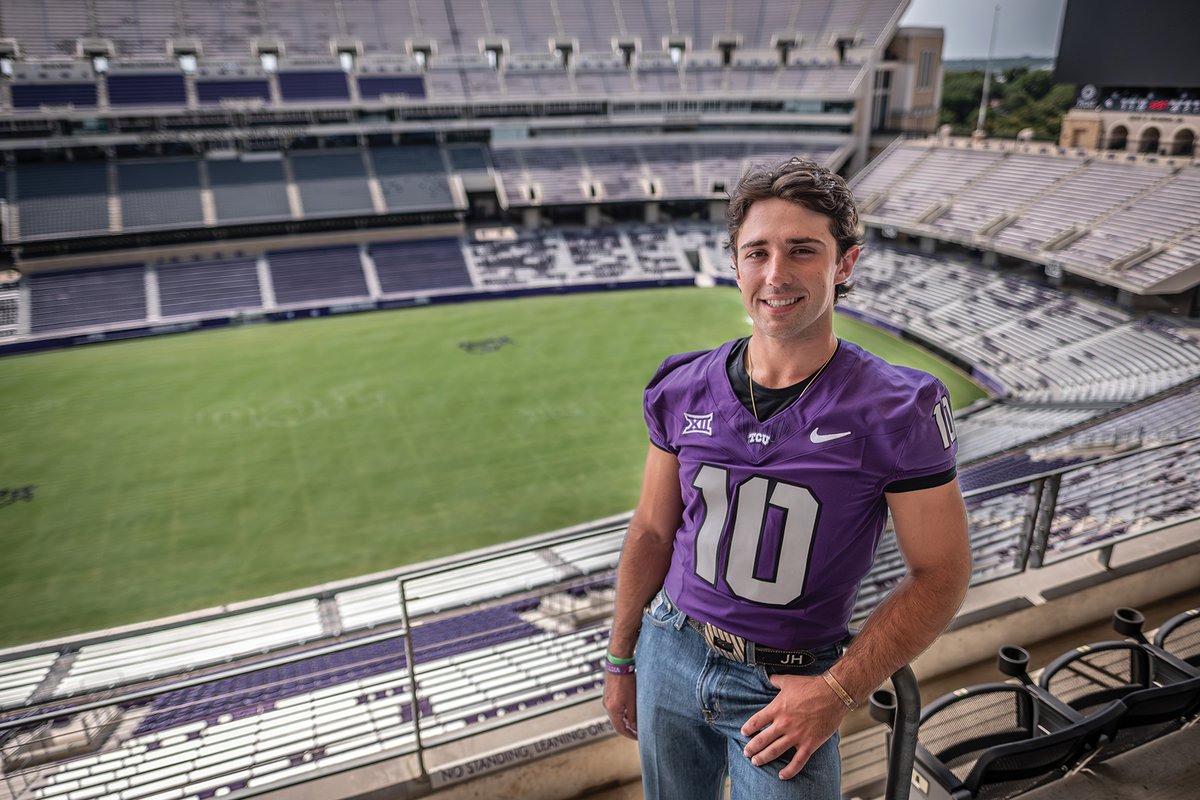
Well, the Dear John letter on Instagram we’ve all been dreading dropped on Thursday.
“First, I want to thank God for the opportunities that he has blessed me with to play this game. I’m so thankful to have had the opportunity to represent TCU for an incredible 4 years. It has been a dream to be able to play and graduate from this university and I will forever be grateful for that.”
But — there’s always a “but” — TCU quarterback Josh Hoover continued, “I will be entering the transfer portal.”
So, there it is. Well, hell. This one hurts because Hoover represented stability in a volatile era of name, image, and likeness, and the specter of the transfer portal. He was “our guy” in a sports culture where “our guy” barely exists anymore.
But alas … .
Josh Hoover is a fantastic person. We wish him the best.
Our man Ken Seals of Azle and then Weatherford High, who traveled back here by way of Vanderbilt, is presumably the starter for TCU’s Alamo Bowl game against Southern Cal. (Everybody remembers the last time TCU lost its starting quarterback right before the Alamo Bowl. It was epic.)
Thankfully, Kansas — the band, that is — taught us all about transience in 1977. Nothing lasts forever, especially in today’s college athletics’ revenue sports. Once upon a time, our guys stayed with us until the eligibility ran out. Today, our college athletes more resemble Mickey Rooney or Jennifer Lopez. (Can you believe that Mickey Rooney found eight wives?)
It’s TCU one day. Indiana the next?
The clickbaiting stations got on this immediately: Where will Josh Hoover land?
Miami, Oregon, Texas Tech. No, Lord, no … not Texas Tech!
The leader in the clubhouse appears to be Indiana, once a hotbed of college basketball. Bob Knight is somewhere beside himself — that is, red-faced and expressing his emotions, shall we say, with the harshest language ever known to man — that the Indiana football program is, one, No. 1 in the country; and, two, that the football coach there is making something like $93 million over eight years.
However, Curt Cignetti has made the Hoosier State a destination for football transfers.
Indiana is also the school Hoover initially committed to as a senior at Rockwall Heath. He had been lightly recruited with only two major suitors — SMU and Indiana. At the helm at SMU at the time was, of course, Sonny Dykes. When Dykes took the TCU job he reached back out to Hoover, who jumped at the chance to come to Fort Worth. He recalled to us in September that on his recruiting visit he “loved it here.”
Things are different at Indiana since Hoover’s change of direction. Different coach and drastically different direction.
Just last year, Hoover turned down a lucrative offer to go to Tennessee. He declined it, he said, because he had already committed to returning to TCU. And the pull of money isn’t the only reason he’s leaving. With one year of eligibility remaining, he likely wants to polish his NFL prospects by playing in bigger games.
That’s not to say that can’t or won’t happen here. But a place like Indiana — whose quarterback this season just won the Heisman Trophy — is likely to open the year in the top 10, playing in the media-darling Big Ten Conference.
Suffice to say, Hoover will be an attractive option for a lot of programs.
His 9,629 passing yards and 71 touchdown passes will likely be the most of any QB in the portal. In 2024, he set a school record with 3,949 passing yards. Hoover also has 17 wins over the past two seasons.
“I want to Thank Coach Dykes for giving me the opportunity to play at TCU. I want to thank Coach Briles and the rest of the coaching staff for pushing me to be my best on and off the field.
“Lastly, I want to thank my teammates for all of the memories that we’ve shared together. This place has allowed me to meet some of my best friends, and I will always be grateful for that. I’ve prayed about this and decided that I will be entering the transfer portal.
“God Bless & Thank you TCU”
We’ll shed a tear, take a sip, and move on. It’s the only option.
So long, farewell, Josh Hoover.
Auf Wiedersehen, goodbye.
NIL
Darian Mensah’s millions give college football players leverage over NFL
Updated Dec. 19, 2025, 4:05 p.m. ET
- Duke quarterback Darian Mensah is returning to college instead of entering the NFL Draft.
- Mensah will earn more money by staying at Duke than he likely would have as an NFL rookie.
- The decision highlights how private NIL deals are making college football competitive with the NFL for talent.
Darian Mensah finally pulled off what eventually had to happen, further underscoring a booming college football economy that isn’t slowing down.
An elite quarterback chose college football over the NFL. And will make more money because of it.
Mensah, who led Duke to its first outright ACC championship since 1962 in his first season after transferring from Tulane, will make — at the very least — the back half of a two-year, $8 million deal he signed prior to this season.
If Mensah were to leave for the NFL, he’d make half that or less for one season — depending on where he was selected in the 2026 NFL Draft.

Stay or go is no longer a professional decision. It’s now, in most cases, a monetary move.
Just when you think paradigm change over the past four years of college football couldn’t be more dramatic, we now have quarterbacks staying in college for more money than they’d earn in the NFL.
College football isn’t the NFL’s minor league. It’s now the NFL’s competition.
The last quarterback selected in the first round of the 2025 NFL Draft was Jaxson Dart, who was the 25th overall pick and signed a four-year deal with the Giants averaging $4.2 million annually.
The first quarterback selected outside the first round was Tyler Shough, who was the 40th overall pick by the Saints and signed a four-year deal averaging $2.7 annually. The next selected was Jalen Milroe, 92nd overall by the Seahawks with a deal averaging $1.56 million annually.
Mensah, who more than likely would’ve been selected somewhere outside the first 50 picks, will earn $4 million by returning to Duke.
But that’s not the point of this exercise. The reality that Mensah will earn more in college football than the NFL, that he is choosing to delay playing at the highest level of football with a multi-year contract to stay in college, should tell you all you need to know about the flourishing private NIL economy.
The one area of unthinkable college football change the NCAA has no control over. And by no, I mean none.
Not with some special clearinghouse, or contrived czar, or play-nice agreement schools are refusing to sign. Private NIL is the heart of the college football economy, the only way to separate the haves from the have-nots.
You don’t really think the haves are going to sit there and take it, do you? They’re not going to nod their heads and spend 75% of their NCAA-mandated $20-23 million annual salary pool on football, and go along their merry way.
Because the elite of the elite players want more, and are they’re getting it through private NIL. It’s basic economics: supply and demand.
Ohio State overpaid for Quinshon Judkins and Will Howard and Caleb Downs, and won a national title because of it. Indiana outbid Georgia and Miami for Fernando Mendoza, and just polished off the first unbeaten regular season in school history.
Duke, meanwhile, won its first outright ACC title in more than six decades after overpaying Mensah. That’s return on investment, everyone.
A similar or marginally better revenue sharing deal isn’t convincing elite players to change schools. Private NIL deals are.
Players don’t have to stay at programs if they feel (take your pick) they’re not being developed properly, don’t have a chance to play for a championship, or just don’t like their situation.
Now they aren’t forced to leave college for the NFL, where the ability to earn was always the greatest draw — no matter what you read from players about taking their talents to (insert team here). Thanks, LeBron.
With that being said, of course.
Imagine the sheer power of telling the NFL no, and then picking up a larger paycheck because of it. And, bonus: Mensah, who has only played two seasons of college football — with at TD/INT ratio of 52/11 — can play another season and strengthen his draft stock.
Go bet on yourself, kid. Have another big season, make twice what you’d earn in the NFL, and then improve your draft stock for 2027. The next thing you know, you’ve moved into a first round projection and your rookie deal goes from seven figures to eight.
Quinn Ewers should’ve done it last season, and there will be more outside of Mensah who will do it this season. Brendan Sorsby and Sam Leavitt could leave for the NFL, and be selected in the first two days.
So could Ty Simpson and John Mateer and Nico Iamaleava. They’ll all make more — per season — in college football with private NIL deals. And that’s just at the quarterback position.
It’s a bear market for the elite of college football, and nothing is stopping it. Not contrived NCAA guidelines with no teeth, and not some document with no legal standing.
And no longer, as crazy as it sounds, the big, bad NFL.
Matt Hayes is the senior national college football writer for USA TODAY Sports Network. Follow him on X at @MattHayesCFB.
NIL
Arch Manning Channels Inner Tom Brady With Selfless NIL Decision
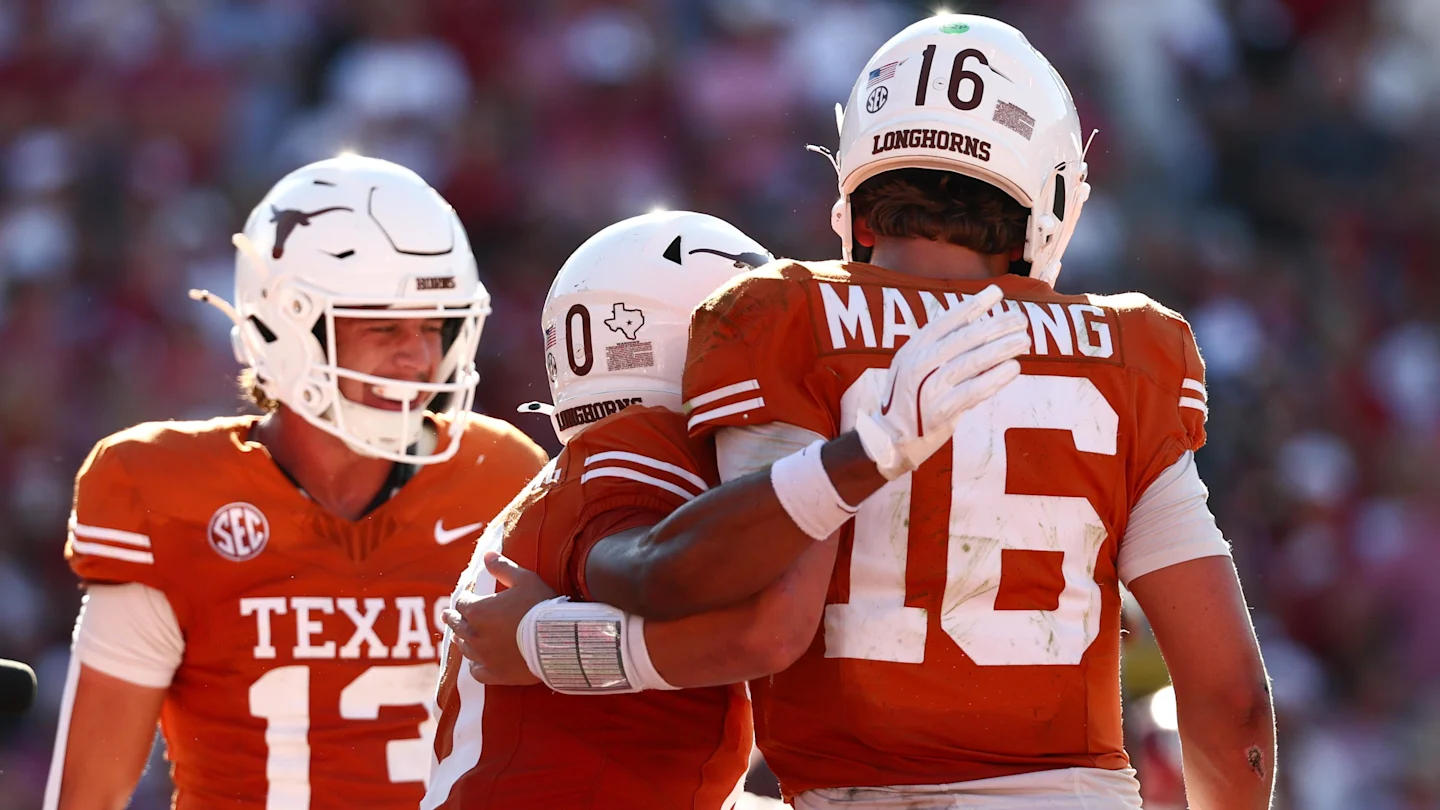
In today’s day and age of college football, the landscape of the sport has dramatically changed.
Now, instead of loyalty, coaches are forced to battle against the tampering of their best players in order to keep them from entering the portal for a big pay day.
And, as has been seen with USC and Texas A&M, players are also now announcing contract extensions to simply forgo that portal temptation, and stay with the school they are currently playing for.
Fortunately – and refreshingly – Texas Longhorns quarterback Arch Manning is taking a different approach.
According to reports from Inside Texas reporter Justin Wells, Manning is set to take a reduced payment from the Longhorns’ 2026 revenue-sharing pool in order to free up money to help his team both retain its own star players, as well as attack the transfer portal to improve the roster for a 2026 championship run.
A Tom Brady-Like Approach From Arch Manning

This move is eerily reminiscent of former NFL superstar Tom Brady, who was famous for taking pay cuts throughout his career in order to help his team acquire players in free agency in hopes of winning a championship.
Dallas Mavericks superstar Dirk Nowitzki also took a similar approach during his time in the NBA, helping Mark Cuban to add firepower to the roster by taking a massive pay cut.
The only difference is that this is college football, and in an era of a ‘look at me and my bank account’ mentality from the vast majority of college football, Manning’s selfless approach is a sight for sore eyes.
Manning Selfless Despite Elite Season
This is especially true considering the fact that Manning deservedly earned a major pay raise in his first season as the starter, completing 227 of 370 passes for 2,942 yards and 24 touchdowns with seven interceptions. He also rushed for 244 yards and led the Longhorns with eight rushing touchdowns, and had a receiving touchdown, accounting for 33 total scores for the season.
And, he was able to do all of that behind a leaky offensive line that ranked 67th in the country in pass blocking grade per PFF, while allowing 159 total pressures and 22 sacks – numbers that could have been much higher if Manning did not have such elite pocket presence and escapability. Not to mention, the offense being encumbered by the worst rushing attack the school had since 1944.
But instead of using that as leverage, like so many other players in the sport, Manning is giving Texas the Brady treatment – allowing them more money to dedicate towards NIL in the transfer portal in hopes of bringing in help to fix the team’s issues up front on the offensive line and in the running game, with potentially multiple additions at the running back spot.
Not to mention, it potentially allows Texas to make some major improvements at wide receiver, linebacker, and defensive back.
His decision also makes it much easier for Texas retain current players on the roster, who have no doubt been receiving tampering-level overtures from other schools and agents.
And it will be made possible in part thanks to a selfless act from Manning, who has now made he desire to win a national championship quite clear.
NIL
$54 million college football HC predicted to be candidate for high-profile NFL job
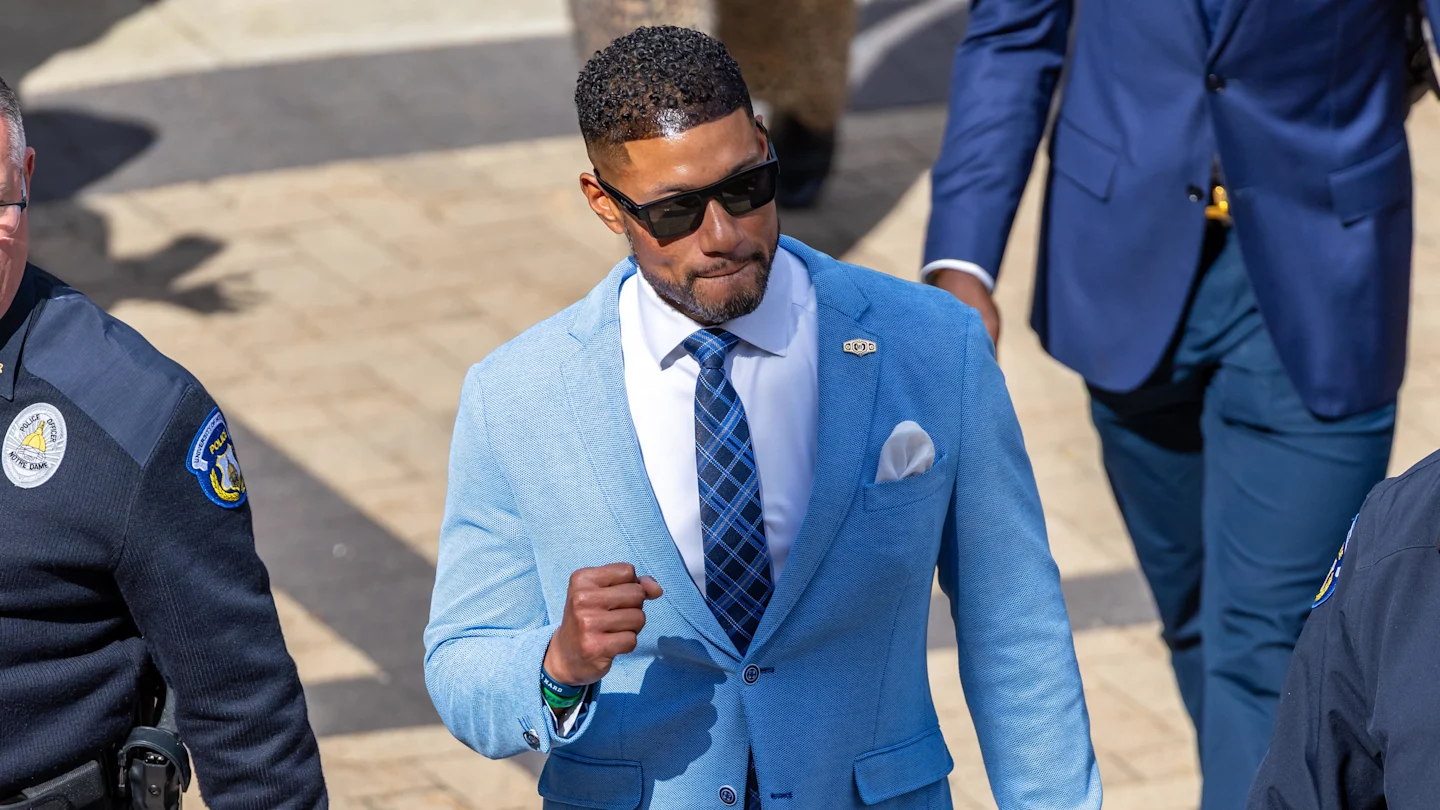
The college football coaching carousel spins on, but now some of that speculation includes one of the most prestigious positions in the NFL which came open this year, and a rising star in the NCAA is now being connected to the vacancy.
Notre Dame head coach Marcus Freeman is someone who should be considered in contention to become the next coach of the New York Giants franchise, according to college football analyst Josh Pate.
Freeman in play for the Giants?
“I just think Marcus Freeman is gonna be in play for the Giants job,” Pate said during an appearance with Bussin’ With The Boys.
“I think a lot of people in the college football administrative world know that/expect that. The agency world knows that/expects that. Not a done deal. I’m not going Schefter.
“If it’s even a remote possibility, and it certainly is, then that means the Notre Dame job may be open, as well. The coaching cycle is not close to done yet.”
NFL insiders seem to agree
The talk connecting Freeman to the Giants is not just random speculation at this point.
Freeman has also emerged as one of the most prominent names on the shortlist being assembled by the Giants franchise itself, according to The Athletic.
That is something to keep an eye on, as the NFL coaching bonanza is only just getting started, and Freeman is considered one of the best young coaching minds in circulation at any level.
LSU, Penn State, and Florida were all reportedly in communication with Freeman through his representatives when those schools were in the market for a coach, and the Giants could be next.
What Freeman has done at Notre Dame
Freeman has just completed his fourth season at the helm of the Fighting Irish program and boasts a 43-12 overall record, winning more than 78 percent of his games.
Freeman led Notre Dame to a No. 2 national ranking and an appearance in the national championship game against his alma mater a year ago.
His team went 10-2 this season and seemed poised for another berth in the College Football Playoff, before the committee reversed course on Selection Day and left the Irish out of the field, leading the school to decline playing in a bowl game.
What Notre Dame is giving Freeman
Freeman, who will turn 40 next month, signed a contract extension with Notre Dame last year that will lock him in with the school through the 2030 season, but if this carousel has proven anything, it’s that almost any contract can be gotten out of.
Notre Dame is a private school and is not obligated to publish its coaching salaries, but insiders contend his deal pays him $9 million per season and is worth a total of a reported $54 million.
But that raise is already somewhat out of date after Indiana recently inked Curt Cignetti to a new deal that will pay him $11.7 million per season.
The most recent reporting contends that Notre Dame and Freeman have not yet reworked his deal with the school, but that both sides are interested in coming to a new arrangement by the new year.
The faster they do that, the faster they can end talk of his leaving.
Read more from College Football HQ
NIL
The Cost of NIL

JACKSON, Miss. (WLBT) – Name, image, and likeness.
It has taken athletics across the amateur level by storm nationally, creating an avenue for players to make money from their NIL, particularly in football.
College football, most notably at the NCAA Division I level, has been forever changed because of it, with one SEC coach calling the state of CFB “sick.”
“We’re trying to sound warning bells. There’s a warning that the system that we are in really is sick right now, and college football is sick,” Missouri head football coach Eli Drinkwitz said about NIL on Monday, December 16, ahead of his team’s appearance in the Gator Bowl. “There’s showing signs of this cracking moving forward… Tampering is at the highest levels – there is no such thing as tampering, because there’s no one that’s been punished for tampering. Everybody on my roster is being called.”
In Mississippi, Ole Miss has benefited from its strong NIL movement, the Grove Collective, which is a large reason why the football program is hosting a College Football playoff game in the school’s first-ever appearance.
But how is NIL affecting high school student-athletes in Mississippi?
Thirty-six states in the country are allowing high school student-athletes to profit from their name, image, and likeness.
Mississippi is not one of them.
“NIL is not for high school students,” Rickey Neaves, the Executive Director of the Mississippi High School Activities Association, said. ”They’re much too young to be taking on that responsibility and handling that large sum of money. So, a high school student and our association need to concentrate on number one, being a young person and enjoying school, enjoying the high school experience, and just being a young man or a young lady. And then the rest of it will take care of itself later on. They’re going to have to work and be responsible later on in life, and long enough. So let them be young while they can.”
According to Yahoo Sports, Fazion Brandon, a five-star recruit playing high school football in North Carolina, is allegedly making $1.2 million in NIL money, who signed several highly publicized contracts since his lawsuit.
Tristen Keys, the highest-rated Mississippi recruit in the class of 2026 and a senior at Hattiesburg High School who signed to play CFB at Tennessee, has an NIL valuation of over $500k, according to On3 Sports.
While not naming the said student-athletes, Neaves confirmed that several Mississippi athletes have been approached every year with a large sum of money with NIL deals since its emergence.
$1.2 and $1.4 million to be exact.
These individuals likely played football in the state, with Mississippi consistently ranking in the top five, and even the best in the country in producing four and five-star talent on the gridiron, multiple reports show.
In fact, 12 high school student-athletes are ranked in ESPN’s Top 300 recruits in the nation, with 5 of them being ranked in the top 100.
That amount of money is hard to turn down for anyone, let alone a high school athlete with the opportunity to achieve dreams at the tip of their finger.
Neaves said turning this opportunity down has impacted a select few of student-athletes in the state.
However, there are ways around signing an NIL contract that can’t be accepted until they graduate and are enrolled in a university.
“They can sign an NIL contract. [But] they or their parents cannot receive any money or any goods that can be escrowed, as we call it, into a bank account for when they do graduate,” Neaves stated. “They cannot use their school logo, their school colors. It does not keep them from using their own name, their own image, and their own likeness, but all of that other belongs either to their school or even to the association, so they can’t use that.”
“We do encourage parents to look into that,” he continued. “I had a deal with a couple of student-athletes last year, and my advice to them was, you can’t tell a young man when they’re 17, 18 years old to turn down $1.2 million. What you can tell them is to be very careful, have that money escrowed and waiting on you once you use your eligibility or once you have graduated, and then build your own name, your own legacy, and build off of that.”
No local student-athletes, according to Neaves, have left the state to pursue NIL deals that are eligible to profit from while in high school.
While the NIL movement hasn’t made its way to high school athletics in the Magnolia State, Neaves suggests another entity is directly affecting high school athletics here.
The transfer portal.
It has changed the landscape of amateur athletics forever, with major colleges able to pay millions in NIL contracts for transfers arguably older and more ready-made for a football program – or any other athletics program, for that matter – to win immediately.
While there are no formal, large-scale academic studies that provide a precise, specific percentage of high schoolers affected, this in turn undoubtedly results in fewer roster spots and scholarship offers for talented high school recruits.
In 2023, an analysis done by Gene’s Page shows that SEC programs’ high school signees dipped nearly 11-percent between 2019 and 2021 as the portal gained prominence.
The FootballScoop stated in an article that in 2021, around 400 fewer players across the country signed FBS scholarships compared to the two cycles prior, and the trend has continued.
Neaves proposes that high school athletes in the state are impacted today.
“We need to look at what that is doing to our high school athletes,“ he warned. ”Right now, we have some outstanding high school athletes, both male and female, who are not getting the opportunity to go on to the next level because these people are still hanging around. They’re gaining some of the six and seven-year college athletes, and that’s not letting today’s seniors in the room. One of these days, NIL money is going to run out, and you have, you have juniors and seniors in college that are staying in college because they’re making more money off their NIL than they would make out of working.”
Is there a future for NIL in Mississippi high school sports?
For the possibility of NIL to maneuver its way into Mississippi high school sports, it would first have to start above the MHSAA.
Neaves doubled down that it is not in the picture within the rules of the association, but that “the legislature could pass a bylaw that says student athletes of high school age can do this.”
“If that ever happened, we would have to stay within the rules ourselves. So, we would have to allow it,“ he said. ”I personally hope that does not happen because I think we have the best option for both worlds here. The student athlete can still have [NIL deals] waiting on them when they get out of school at any time in their life, when they are more adapted to [the] use of it and can benefit from it even more.”
It does remain a possibility, however.
More states are trending towards allowing high schoolers to make NIL money.
On November 25, Ohio became the latest state to join the NIL movement.
While it is technically out of Neaves’ control, he does encourage that high school sports remain the same in Mississippi.
“You never know in today’s world what’s going to be coming down the pipe, but I think you have to always look ahead and see what pitfalls are out there.”
“Let’s be realistic. Is a 16 or 17-year-old mature enough to handle a million dollars? No. I know when I was that age, I would have blown it and probably ruined my whole career while doing it. Now, that’s not what everybody would do, but if that happens to one person, that’s one too many.”
Want more WLBT news in your inbox? Click here to subscribe to our newsletter.
See a spelling or grammar error in our story? Please click here to report it and include the headline of the story in your email.
Copyright 2025 WLBT. All rights reserved.
NIL
Arch Manning Is Taking A Pay Cut To Help Texas Gain An Edge
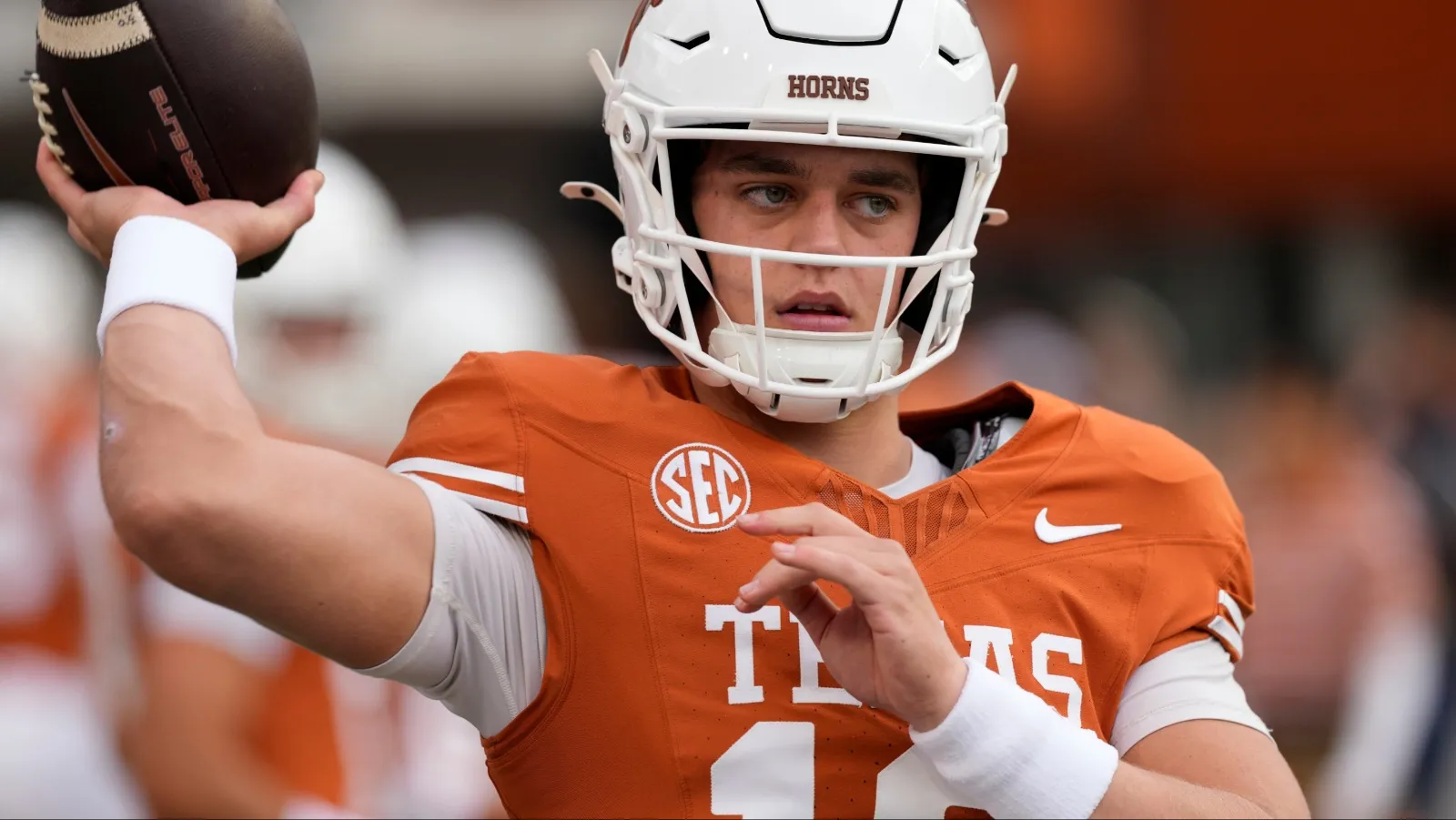
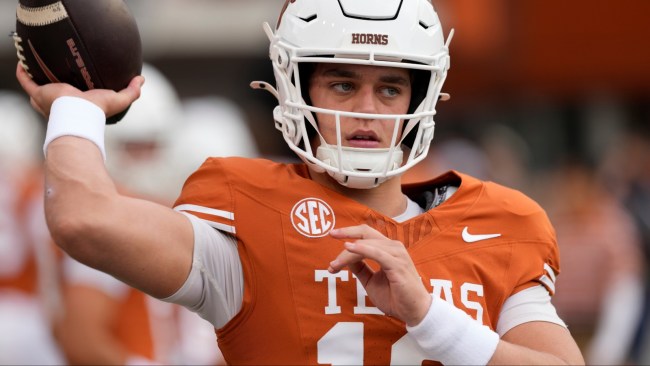
© Scott Wachter-Imagn Images
College football has been skidding down a slippery slope since the start of the NIL Era, and the line between that level and the pros gets blurrier with every year that passes. Now, we’ve been treated to our latest shift on that front courtesy of Arch Manning’s decision to take a pay cut ahead of his second season as the starter for Texas.
Next summer will mark the fifth anniversary of the landmark Supreme Court decision that essentially forced the NCAA to abandon its longstanding efforts to prevent students from cashing in on their name, image, and likeness.
It was a fairly inevitable development and one that was poised to have a dramatic impact on the landscape of college sports. While most fans agreed that student-athletes deserved to make some money, the ways in which they’re now able to do so have slowly but surely eroded the spirit of collegiate athletics as the concept of amateurism becomes a memory of the past.
That evolution has been marked by a number of tangible signposts, and the latest stake has been pounded into the ground courtesy of Arch Manning.
Arch Manning is taking a pay cut to allow Texas to use more of its House settlement funds on other talent
Earlier this week, we were treated to the latest piece of evidence that college football is basically a pro sport when USC went out of its way to announce running back Waymond Jordan had re-signed with the program after deciding to return to the Trojans for a second season.
We’ve reached a point where every player is effectively a free agent when their season comes to an end due to the transfer portal, and schools now have even more money they can use to try to poach and retain talent in the wake of the House settlement that will allow athletic departments to redistribute up to $20.5 million in revenue to athletes during the current academic year.
According to Texas Insider, the University of Texas is setting aside around $14 million for its football program next season. Arch Manning will undoubtedly receive a significant chunk of that sum, but the outlet spoke with sources who say the quarterback will accept “a reduced compensation” from the Longhorns so they can spend more money on other players in pursuit of a national championship.
Manning certainly isn’t hurting for cash, as he reportedly received at least $3.5 million this season thanks to NIL deals with companies including Red Bull, Uber, and Warby Parker.
It’s a commendable move for a QB who will be looking to improve after largely failing to meet the admittedly lofty expectations surrounding him during a campaign where the Longhorns went 9-3, but it’s also one that shows the sport has firmly reached the point of no return.
-

 Motorsports1 week ago
Motorsports1 week agoSoundGear Named Entitlement Sponsor of Spears CARS Tour Southwest Opener
-

 NIL3 weeks ago
NIL3 weeks agoBowl Projections: ESPN predicts 12-team College Football Playoff bracket, full bowl slate after Week 14
-

 Rec Sports3 weeks ago
Rec Sports3 weeks agoRobert “Bobby” Lewis Hardin, 56
-
Sports3 weeks ago
Wisconsin volleyball sweeps Minnesota with ease in ranked rivalry win
-

 Motorsports2 weeks ago
Motorsports2 weeks agoDonny Schatz finds new home for 2026, inks full-time deal with CJB Motorsports – InForum
-

 Rec Sports2 weeks ago
Rec Sports2 weeks agoHow Donald Trump became FIFA’s ‘soccer president’ long before World Cup draw
-
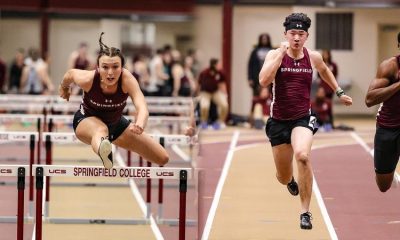
 Sports3 weeks ago
Sports3 weeks agoMen’s and Women’s Track and Field Release 2026 Indoor Schedule with Opener Slated for December 6 at Home
-

 Motorsports3 weeks ago
Motorsports3 weeks agoMichael Jordan’s fight against NASCAR heads to court, could shake up motorsports
-

 Rec Sports2 weeks ago
Rec Sports2 weeks agoBlack Bear Revises Recording Policies After Rulebook Language Surfaces via Lever
-

 Motorsports2 weeks ago
Motorsports2 weeks agoJR Motorsports Confirms Death Of NASCAR Veteran Michael Annett At Age 39































